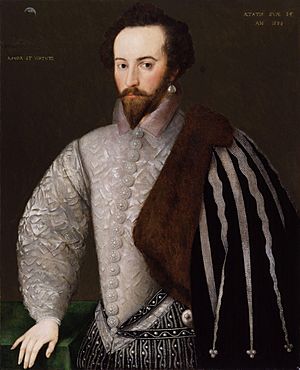The Nymph's Reply to the Shepherd facts for kids
The Nymph’s Reply to the Shepherd is a famous poem written in 1600 by Walter Raleigh. It's a "reply poem" because it was written as an answer to another well-known poem called “The Passionate Shepherd to His Love” (1599) by Christopher Marlowe. In Marlowe's poem, a shepherd tries to convince a young woman, called a nymph, to live with him in the countryside. Raleigh's poem is the nymph's answer, where she explains why she can't accept his offer.
The nymph in the poem is a character from old Greek stories. She represents nature and shows that things like life, youth, and love don't last forever. She tells the shepherd that if the world were perfect and everything lasted, she would gladly live with him. But she reminds him that good things, like flowers, don't stay beautiful forever. In Marlowe's poem, the flowers stand for youth, but the nymph points out that even youth eventually fades away.
Both poems are written in a style called pastoral poetry. This means they are about a simple, peaceful life in the countryside. They both have six stanzas, and each stanza has four lines. The lines rhyme in a simple AABB pattern, meaning the first two lines rhyme, and the next two lines rhyme.
"The Nymph’s Reply to the Shepherd" was written during the Elizabethan era (1558–1603), a time when Queen Elizabeth I ruled England. Many poets wrote reply poems back then. Later, in the 1900s, another poet named William Carlos Williams even wrote a poem called Raleigh was Right (1940), which agreed with Walter Raleigh's point of view over Christopher Marlowe's.
The Nymph's Reply to the Shepherd Poem
Here is the full poem by Walter Raleigh:
If all the world and love were young,
And truth in every shepherd's tongue,
These pretty pleasures might me move
To live with thee and be thy love.
Time drives the flocks from field to fold
When Rivers rage and Rocks grow cold,
And Philomel becometh dumb;
The rest complains of cares to come.
The flowers do fade, and wanton fields
To wayward winter reckoning yields;
A honey tongue, a heart of gall,
Is fancy's spring, but sorrow's fall.
Thy gowns, thy shoes, thy beds of roses,
Thy cap, thy kirtle, and thy posies
Soon break, soon wither, soon forgotten:
In folly ripe, in reason rotten.
Thy belt of straw and Ivy buds,
Thy coral clasps and amber studs,
All these in me no means can move
To come to thee and be thy love.
But could youth last and love still breed,
Had joys no date nor age no need,
Then these delights my mind might move
To live with thee and be thy love.


